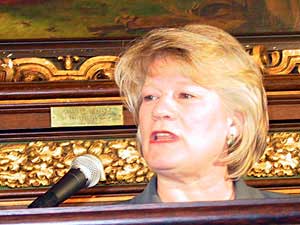|
Audio
Photos
More from MPR
Resources
Your Voice
|
Metro highway plan set to move forward
September 17, 2003
 |
| Lt. Gov. and MnDOT chief Carol Molnau is leading the effort to speed up transportation funding for some major projects around the state, including several in the Twin Cities. (MPR file photo) |
St. Paul, Minn. — The Met Council is poised to approve one of the biggest increases in Twin Cities transporation spending in history. Lawmakers last session approved nearly $900 million in new bonding for transportation. About two-thirds is for Twin Cities projects.
Donn Wiski, the Metropolitan Council's Transportation Advisory Board chairman, says the money is in addition to the $1.7 billion already being spent over the next three years.
"So when you add $600 million to that, you're talking about a one-third increase. So that's a significant amount of addition," says Wiski.
The big winners are suburban residents. The largest amount of road and bridge spending -- $225 million -- is for a new expressway, the long-awaited Highway 212 project through Eden Prairie in the southwestern portion of the Twin Cities. There's also money for the long-awaited upgrade of the Twin Cities beltways, I-494 and I-694.
|
Our region spends about half of what regions of similar size spend on public transit. And we're reducing it ... while other regions are increasing it.
- Barb Thoman, Met Council |
Met Council transporation committee chair Mary Hill Smith says the additional money addresses lots of problems.
"Not only does it move forward some improvements of the rings -- the 494, 694 process -- and make us have, for the first time there when completed, three lanes all the way around our region. And it also improves and corrects some interregional corridors, it also gives us some opportunities to improve transit," says Smith.
The transit spending amounts to $36 million to expand the use of bus shoulder lanes on Twin Cities roadways, and additional park and ride lots. There's $140 million to complete and operate the Hiawatha light rail line.
As usual, literally dozens of smaller projects to expand intersections or streamline highway interchanges lost out in this round of spending, and will have to wait for the next one. Different this time, Barb Thoman says, is the favored status of Highway 212. Thoman sits on the Met Council's Transportation Advisory Board, and is a spokeswoman for Transit for Livable Communities, a public policy group.
"Highway 212 in the southwest metro gets the greatest percentage of the bond funding, while it's not even listed as a short term priority in MnDOT's plan," says Thoman.
Highway 212 has been controversial since the debut of the first rebuilding plan 50 years ago. Part of its success in leapfrogging ahead of other projects is due to decades of lobbying by developers, commuters and the current MnDot commissioner and Lt. Gov. Carol Molnau.
Business played a more prominent role in deciding how to spend the additional Twin Cities transporation money. Chambers of commerce made sure they were part of the planning process. A spokeswoman says the chamber members endorse the outcome, but she adds, the members want a multimodal Twin Cities transportation system.
Transporation Advisory Board member Barb Thoman says the Twin Cities is falling behind other areas of the country in transit spending.
"Our region spends about half of what regions of similar size spend on public transit. And we're reducing it -- the amount that we spend, what we invest -- while other regions are increasing it," Thoman says.
Others argue that some of the road building money can be counted as transit spending, because the new lanes for traffic can also be used by buses. However that argument is tempered with the reality that Metro Transit has had to reduce service to cope with the loss of state funds.
|
News Headlines
|
Related Subjects
|
